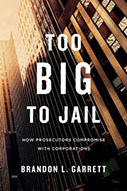Too Big To Jail: How Prosecutors Compromise with Corporations

Author: Brandon L. Garrett
Publisher: Cambridge, MA: Harvard University Press, 2014. 384 p.
Reviewer: Miriam H. Baer | May 2015
Brandon Garrett’s wide-ranging book on corporate prosecutions addresses several audiences at once. Written in a user-friendly voice, it carefully explains the law of corporate criminal liability and federal criminal procedure. Using vivid snippets of court testimony, it tells the stories of infamous and lesser-known prosecutions of corporate titans such as Arthur Andersen, KMPG and British Petroleum. For the novice, it is a great read.
Given the book’s emphasis, those who study corporate criminal liability from a theoretical perspective may well conclude that this book is not for them. This, however, would be a mistake, as Garrett’s normative claims and policy arguments merit engagement and response.
Garrett’s book offers the most sustained attack to date on the deferred prosecution agreement (DPA). Until recently, the DPA appeared to be the federal government’s preferred method for concluding criminal investigations of publicly held corporations. When individuals are charged with a crime, they must decide between pleading guilty or taking their chances with a trial. Corporations, by contrast, may elect a third alternative: entering an agreement with the federal prosecutor whereby the prosecutor agrees to defer prosecution while the corporate defendant agrees to pay certain fines, cooperate in the government’s investigation, and make certain governance and compliance-related reforms. This third alternative has garnered the attention and criticism of scholars, practitioners and lawmakers.
Like many, Garrett worries that federal prosecutors have unintentionally created a “too big to jail” culture among corporate executives, although he pairs these fears with some measured sympathy for federal prosecutors. He praises their dedication (271) and takes seriously the concern that corporate indictments might, in some cases, unleash substantial and harmful collateral effects. (59) Garrett generally likes the idea of rehabilitating fallen corporations (47), and commends the government for engineering significant reforms within KPMG and HSBC and their respective industries (79-80, 103).
So much for the good news. The rest of the book casts corporate criminal enforcement policy in a decidedly negative light. Through a series of anecdotes interwoven with empirical analysis, Garrett affirms the oft-stated concern that government elites have been too soft on corporate crime. (65-66).
Garrett’s argument for reform divides in two parts. The first, and most persuasive, is his call for greater transparency: the government should be more open about how it decides to charge a corporation and it should also document how well the various reforms agreed to in DPA’s have performed over the long term.
It is difficult to quibble with Garrett’s transparency arguments. Over the past two decades, the federal government has entered into at least three hundred deferred or non-prosecution agreements with corporate entities, from which Garrett has constructed and analyzed a data set of 255 agreements that were completed from 2001-12. (291-305). Unfortunately, as Garrett points out, the government’s decentralized and less-than-perfect record keeping substantially limits his empirical analysis. (7-8). Some agreements have either been lost or kept from the public (64), and there exists no publicly available account of how many corporate cases prosecutors have declined to prosecute at all, much less the reasons underlying those declinations. (254).
Although the government has long adhered to a multi-factor rubric to guide its corporate charging decisions, its explanations for applying the DPA are not particularly illuminating. (63). Rather, as Garrett observes, the DPA tends to include boilerplate language lauding the company’s “extraordinary cooperation” and sometimes citing the collateral consequences the parties sought to avoid by entering a DPA in lieu of formal charges. (63).
As Garrett observes, the DPAs themselves do not convey the government’s success in reforming corporate compliance. Citing the corporate culture literature, Garrett presumes this to be a monumental task (57), and one that prosecutors often shortchange. Indeed, as Garrett declares towards the end of the book, prosecutors do not even seem to know how to measure, much less define, “effective compliance.” (279).
Garrett may well be right, but organizational compliance is a nascent discipline, and our society has a long way to go before it reaches consensus on how best to measure it. Even if one believes strongly that corporations should self-police, it is difficult to conjure an objective and reliable test for discerning good “structural reform” from window dressing or faddish overreaching. Given the compliance industry’s relative youth, one might well conclude that the parties best positioned to devise measurement tools are regulatory experts and not generalist prosecutors.
The second prong of Garrett’s critique is that federal prosecutors compromise too much, allowing offenders to avoid guilty pleas and enter into relatively cushy settlement agreements. At one point, Garrett wonders if “prosecutors take compliance seriously.” (276). Elsewhere, he rebukes prosecutors for negotiating insufficiently punitive criminal fines, which are often obscured by restitution and other payments companies make in order to settle investigations. (67-70).
In sum, prosecutors have failed to impose sufficiently substantial penalties on criminal corporate actors. (285). To overcome this problem, Garrett advocates a series of reforms. Prosecutors should indict corporations more often and abandon the DPA in all but the most pressing situations. (17). Judges should supervise all deferred prosecution and corporate plea agreements and should recruit external monitors to supervise more extensive structural reforms. (17-18). Judges should also consider the “public interest” when reviewing corporate plea agreements and should reject those agreements when they appear insufficiently demanding of corporate defenders. (273, 282).
Interestingly, and perhaps because he has written this book for a general audience, Garrett does not devote many pages to discussing whether an inanimate entity such as a corporation can or should be blamed for its members’ wrongdoing. His preferred focus, Garrett tells us, is “whether corporate prosecutions are actually effective in preventing crime.” (4). But Garrett clearly cares about more than the mere prevention of corporate crime, as he cites moral condemnation as a proper goal of criminal punishment. (274).
Thus, one cannot help but wonder: which purpose should be paramount in confronting corporate crime? Presumably, Garrett would respond that his reforms serve retributive and deterrence-oriented goals equally. Nevertheless, as one spends time contemplating the book’s critique and proposed reforms, one cannot help but conclude that familiar notions of desert propel Garrett’s argument far more than standard deterrence theory. Were deterrence Garrett’s sole or even primary concern, it is doubtful he would voice so much concern over the fact that the corporation’s criminal fine is often “dwarfed” by civil or regulatory fines. (125). Nor would he care that corporate fines reflect a tiny percentage of corporate defendants’ market capitalization. (262).
Moreover, were Garrett concerned solely with the prevention of corporate crime, one might expect him to focus at length on the tradeoffs between seeking higher sanctions and reducing the government’s probability and speed of detection. Although Garrett cites Jennifer Arlen’s work establishing the need for government leniency to induce corporate self-policing (56), he declines to consider the extent to which his proposed reforms might reduce the number of prosecutions in any given year and thereby induce delays in punishment and corporate rehabilitation.
Enforcement reform is, by nature, speculative. Garrett’s proposed reforms might have no effect at all on how quickly or effectively the government detects and punishes wrongdoing; alternatively, they might improve detection by inducing corporations to police themselves. Nevertheless, it is at least plausible that they would weaken detection by forcing prosecutors to spend more time in court hashing out the terms and enforcement of each corporate reform agreement, leaving them less capacity to investigate additional cases. One cannot help but wonder how Garrett would respond to this third scenario. Faced with a stark choice between deterrence and desert (and no extra funds from Congress), which lever would he choose?
As Garrett himself observes, the deferred prosecution agreement has garnered attacks not only from those concerned by too little intervention, but also from those who fear too excessive government involvement in corporate affairs. Garrett’s overriding concern is the former (74-75), although he duly notes some cases in which prosecutors have extracted concessions that seemingly have little to do with the corporation’s future adherence to law (76-77). But he seems quite content with those agreements (admittedly less common) that enable prosecutors to dictate how corporations should govern themselves, including on matters such as executive compensation and the hiring of key corporate personnel. (72-73). Later, Garrett tells his readers that he would not want prosecutors to become “superregulators” or make “ill-considered changes in corporate governance,” (276), but it is unclear what constitutes an “ill-considered change” and one wonders how consistently federal judges would parse such a standard.
When discussing the use of third-party monitors, Garrett cites civil rights litigation as his model. (7, 176-77). The analogy, however interesting, raises more questions than it answers. The federal government’s intervention in a local school district, prison or police department to ensure citizens’ constitutional rights differs pragmatically and philosophically from its oversight of a company’s internal affairs to assure greater compliance with federal law. None of this is to deny the importance of legal compliance or corporate governance reform, but reasonable people can disagree on who should play the dominant role in spearheading and implementing it.
Although much of Garrett’s critique concerns the government’s treatment of corporate entities, he reserves a fair amount of space for corporate executives. Of the 255 deferred and non-prosecution agreements analyzed by Garrett, only one third were accompanied by prosecutions of the corporation’s employees. (13, 83). To the extent DPAs are premised on corporate America’s cooperation in federal investigations, Garrett is indeed right to wonder where all that cooperation has gone. Then again, Garrett’s numbers do not tell the entire story. The DPA process itself may motivate some corporations to proactively report rogue officials, as Morgan Stanley did with one of its executive directors in 2012. Because Morgan Stanley was never charged, its proactive approach would not be captured by Garrett’s data. The DPA process might also improve the government’s pursuit of non-criminal penalties against individuals, which also is not reflected in the three-to-one ratio.
In any event, the story is not really about numbers at all. Garrett’s concern lies not with the non-prosecution of low-level employees, but rather with weak-kneed treatment of high-level executives who commonly claim ignorance of the nefarious conduct that has pervaded their organizations. Garrett argues that prosecutors can overcome knowledge hurdles by relying more often on the so-called “ostrich instruction,” which advises jurors that “willful” blindness can be the equivalent of knowledge. (82, 108). But, as Garrett himself recognizes, willful blindness is a narrow doctrine, and requires proof that the defendant engaged in a deliberate act to avoid confirming the truth of a particular matter. (82). Surely, many corporate executives either failed to engage in such acts or did so in a way that cannot be easily proven.
Recognizing individual liability’s limitations, Garrett concludes his discussion by arguing for more extensive organizational reforms. If the government cannot hold the corporation’s high-level personnel accountable for their bad acts, Garrett tells us, then it should “vigilantly pursue” structural reforms within organizations. (115-16). Here again, one wonders how this argument fares under an explicitly retributive and consequentialist framework. If the corporation deserves moral condemnation because of its acts or omissions, why should the government’s ability to prosecute high-level executives matter at all? On the other hand, if the primary concern is prevention and deterrence, why not promulgate certain ex ante regulations that apply equally to all members of a given industry?
At bottom, how one views Too Big to Jail depends greatly on how one perceives criminal law enforcement and corporate malfeasance. For those who believe government prosecutors have been too light on corporate America, Garrett’s book provides welcome ammunition. For those more skeptical of corporate criminal liability, Garrett’s arguments provide food for thought. And finally, the book itself offers a prescient warning to federal prosecutors: It is relatively easy to prosecute a corporate entity, but quite difficult to reform it. Should you choose the latter, be prepared to receive criticism from those on all sides of the debate.


